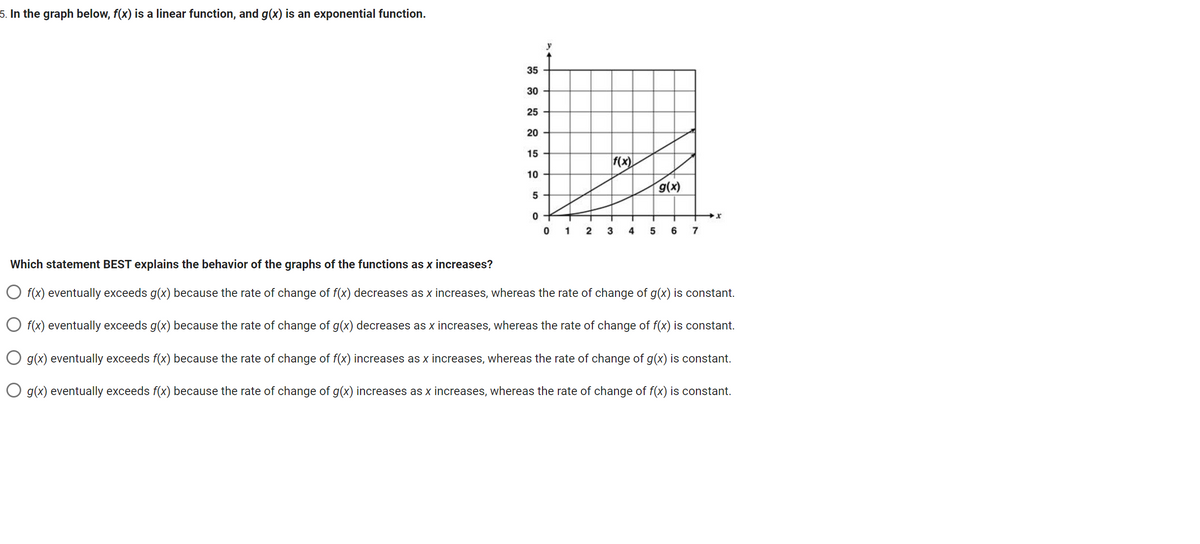35 30 25 20 15 10 5 f(x) g(x) 0 0 1 3 4 5 6 7 Which statement BEST explains the behavior of the graphs of the functions as x increases? O f(x) eventually exceeds g(x) because the rate of change of f(x) decreases as x increases, whereas the rate of change of g(x) is constant. O f(x) eventually exceeds g(x) because the rate of change of g(x) decreases as x increases, whereas the rate of change of f(x) is constant. O g(x) eventually exceeds f(x) because the rate of change of f(x) increases as x increases, whereas the rate of change of g(x) is constant. O g(x) eventually exceeds f(x) because the rate of change of g(x) increases as x increases, whereas the rate of change of f(x) is constant.
35 30 25 20 15 10 5 f(x) g(x) 0 0 1 3 4 5 6 7 Which statement BEST explains the behavior of the graphs of the functions as x increases? O f(x) eventually exceeds g(x) because the rate of change of f(x) decreases as x increases, whereas the rate of change of g(x) is constant. O f(x) eventually exceeds g(x) because the rate of change of g(x) decreases as x increases, whereas the rate of change of f(x) is constant. O g(x) eventually exceeds f(x) because the rate of change of f(x) increases as x increases, whereas the rate of change of g(x) is constant. O g(x) eventually exceeds f(x) because the rate of change of g(x) increases as x increases, whereas the rate of change of f(x) is constant.
Functions and Change: A Modeling Approach to College Algebra (MindTap Course List)
6th Edition
ISBN:9781337111348
Author:Bruce Crauder, Benny Evans, Alan Noell
Publisher:Bruce Crauder, Benny Evans, Alan Noell
Chapter5: A Survey Of Other Common Functions
Section5.3: Modeling Data With Power Functions
Problem 8E: Growth Rate Versus Weight Ecologists have studied how a populations intrinsic exponential growth...
Related questions
Question

Transcribed Image Text:5. In the graph below, f(x) is a linear function, and g(x) is an exponential function.
g(x)
0
0
1 2
3
4
5 6 7
Which statement BEST explains the behavior of the graphs of the functions as x increases?
O f(x) eventually exceeds g(x) because the rate of change of f(x) decreases as x increases, whereas the rate of change of g(x) is constant.
O f(x) eventually exceeds g(x) because the rate of change of g(x) decreases as x increases, whereas the rate of change of f(x) is constant.
g(x) eventually exceeds f(x) because the rate of change of f(x) increases as x increases, whereas the rate of change of g(x) is constant.
O g(x) eventually exceeds f(x) because the rate of change of g(x) increases as x increases, whereas the rate of change of f(x) is constant.
35
30
25
20
15
10
сл
f(x)
X
Expert Solution
This question has been solved!
Explore an expertly crafted, step-by-step solution for a thorough understanding of key concepts.
This is a popular solution!
Trending now
This is a popular solution!
Step by step
Solved in 2 steps

Recommended textbooks for you

Functions and Change: A Modeling Approach to Coll…
Algebra
ISBN:
9781337111348
Author:
Bruce Crauder, Benny Evans, Alan Noell
Publisher:
Cengage Learning

Algebra & Trigonometry with Analytic Geometry
Algebra
ISBN:
9781133382119
Author:
Swokowski
Publisher:
Cengage

Algebra and Trigonometry (MindTap Course List)
Algebra
ISBN:
9781305071742
Author:
James Stewart, Lothar Redlin, Saleem Watson
Publisher:
Cengage Learning

Functions and Change: A Modeling Approach to Coll…
Algebra
ISBN:
9781337111348
Author:
Bruce Crauder, Benny Evans, Alan Noell
Publisher:
Cengage Learning

Algebra & Trigonometry with Analytic Geometry
Algebra
ISBN:
9781133382119
Author:
Swokowski
Publisher:
Cengage

Algebra and Trigonometry (MindTap Course List)
Algebra
ISBN:
9781305071742
Author:
James Stewart, Lothar Redlin, Saleem Watson
Publisher:
Cengage Learning


College Algebra
Algebra
ISBN:
9781305115545
Author:
James Stewart, Lothar Redlin, Saleem Watson
Publisher:
Cengage Learning

Big Ideas Math A Bridge To Success Algebra 1: Stu…
Algebra
ISBN:
9781680331141
Author:
HOUGHTON MIFFLIN HARCOURT
Publisher:
Houghton Mifflin Harcourt